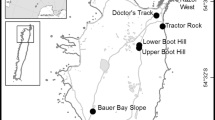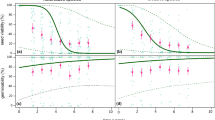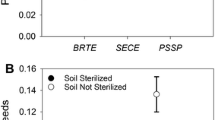Abstract
Acacia dealbata is an invasive south-eastern Australian tree that produces a persistent soil seed bank. In order to characterize the seed bank in plots invaded by A. dealbata and to understand its implications for management and re-invasion risk, density, germinability, and viability of the seed bank were evaluated in five sites in central Portugal. Soil samples were collected in A. dealbata invaded plots and adjacent areas and screened for seeds, which were then quantified and germinated at 25 °C. A subset of seeds was first exposed to 60 °C to assess the effect of high soil temperature on dormancy breaking. Variables influencing differences between sites were explored with generalized linear mixed models with a Poisson distribution. Inside A. dealbata invaded plots the seed bank averaged 4608 seeds/m2, reaching up to 62,747 seeds/m2; in adjacent areas, up to 14 m from the plots, only 9 seeds/m2 were found. Seed bank densities were mostly influenced by stoniness, number of fires in the last 10 years, and density of trees and roots. Almost 90% of seeds were viable, but only 8.6% germinated without treatment. Nearly 70% of seeds exposed to 60 °C germinated without any physical stimulation, suggesting that high soil temperatures can effectively break seed dormancy. The high density and viability of A. dealbata’s seed bank and its ability to disperse seeds far from the parent plants contribute to the species’ invasive success. These features combined with heat events that can overcome seed dormancy need to be considered in the management of this species.






Similar content being viewed by others
References
Adair RJ (2008a) Galling guilds associated with Acacia dealbata and factors guiding selection of potential biological control agents. In: Julien MH, Sforza R, Bon MC, Evans HC, Hatcher P E, Hinz HL, Rector BG (eds) Proceedings of the XII International Symposium on Biological Control of Weeds. La Grande Motte, France, pp 122–128, 22–27 Apr 2007
Adair RJ (2008b) Biological control of Australian native plants, in Australia, with an emphasis on acacias. Muelleria 26(1):67–78
Akaike H (1974) A new look at the statistical model identification. IEEE Trans Automat Contr 19(6):716–723
Andreu J, Vilà M (2007) Análisis de la gestión de las plantas exóticas en los espacios naturales españoles. Ecosistemas 16(3):109–124
Bolker BM, Brooks ME, Clark CJ, Geange SW, Poulsen JR, Stevens MH, White JS (2008) Generalized linear mixed models: a practical guide for ecology and evolution. Trends Ecol Evolut 24(3):127–135
Bradstock RA, Auld TD (1995) Soil temperatures during experimental bushfires in relation to fire intensity: consequences for legume germination and fire management in south-eastern Australia. J Appl Ecol 32:76–84
Correia M, Castro S, Ferrero V, Crisóstomo JA, Rodríguez-Echeverría S (2014) Reproductive biology and success of invasive Australian acacias in Portugal. Bot J Linnean Soc 174:574–588
Crisóstomo JA, Freitas H, Rodríguez-Echeverría S (2007) Relative growth rates of three woody legumes: implications in the process of ecological invasion. Web Ecol 7:22–26
D’Antonio C, Meyerson LA (2002) Exotic plant species as problems and solutions in ecological restoration: a synthesis. Restor Ecol 10(4):703–713
DAISIE European Invasive Alien Species Gateway (2006) Acacia dealbata. http://www.europe-aliens.org/speciesFactsheet.do?speciesId=12749 Accessed 11 Jan 2014
Dormann CF, Elith J, Bacher S, Buchmann C, Carl G, Carré G, García Marquéz JR, Gruber B, Lafourcade B, Leitão PJ, Münkemüller T, McClean C, Osborne PE, Reineking B, Schröder B, Skidmore AK, Zurell D, Lautenbach S (2013) Collinearity: a review of methods to deal with it and a simulation study evaluating their performance. Ecography 36:27–46
Fernandes MM (2008) Recuperação Ecológica de Áreas Invadidas por Acacia dealbata Link no Vale do Rio Gerês: Um Trabalho de Sísifo? Master Dissertation, University of Trás-os-Montes e Alto Douro, Portugal
Fournier DA, Skaug HJ, Ancheta J, Ianelli J, Magnusson A, Maunder M, Nielsen A, Sibert J (2012) AD Model Builder: using automatic differentiation for statistical inference of highly parameterized complex nonlinear models. Optim Methods Softw 27:233–249
Fuentes-Ramirez A, Pauchard A, Lohengrin AC, García RA (2011) Survival and growth of Acacia dealbata vs native trees across an invasion front in south-central Chile. For Ecol Manag 261:1003–1009
Gibson MR, Richardson DM, Marchante E, Marchante H, Rodger JG, Stone GN, Byrne M, Fuentez-Ramírez A, George N, Harris C, Johnson SD, Le Roux JL, Miller JT, Murphy DJ, Pauw A, Prescott MN, Wandrag EM, Wilson JRU (2011) Reproductive biology of Australian acacias: important mediator of invasiveness? Divers Distrib 17:911–933
Gioria M, Pyšek P, Moravcová L (2012) Soil seed banks in plant invasions: promoting species invasiveness and long-term impact on plant community dynamics. Preslia 84:327–350
Horta MC (2014) Dados climáticos referentes a 2013—Posto meteorológico da Escola Superior Agrária. Instituto Superior de Castelo Branco, Portugal
Hosmer DW, Lemeshow S (2000) Applied logistic regression, 2nd edn. John Wiley & Sons Inc, Hoboken, p 375
ICN (2006). Plano Sectorial da Rede Natura 2000. Flora. Instituto da Conservação da Natureza, Direcção de Serviços da Conservação da Natureza, Lisboa
Le Maitre DC, Gaertner M, Marchante E, Ens EJ, Holmes PM, Pauchard A, O’Farrell PJ, Rogers AM, Blanchard R, Blignaut J, Richardson DM (2011) Impacts of invasive Australian acacias: implications for management and restoration. Divers Distrib 17:1015–1029
Lorenzo P, Gonzáles L, Reigosa MJ (2010) The genus Acacia as invader: the characteristic case of Acacia dealbata Link in Europe. Ann For Sci 67:101
Lorenzo P, Pazos-Malvido E, Rubido-Bará M, Reigosa MJ, González L (2012) Invasion by the leguminous tree Acacia dealbata (Mimosaceae) reduces the native understory plant species in different communities. Aust J Bot 60:669–675
Marais C, van Wilgen BW, Stevens D (2004) The clearing of invasive alien plants in South Africa: a preliminary assessment of costs and progress. S Afr J Sci 100:97–103
Marchante H, Freitas H, Hoffmann JH (2011a) Post-clearing recovery of coastal dunes invaded by Acacia longifolia: is duration of invasion relevant for management success? J Appl Ecol 48(5):1295–1304
Marchante H, Freitas H, Hoffmann JH (2011b) Assessing the suitability and safety of a well-known bud-galling wasp, Trichilogaster acaciaelongifoliae, for biological control of Acacia longifolia in Portugal. Biol Control 56:193–201
Marchante H, Morais M, Freitas H, Marchante E (2014) Guia prático para a identificação de Plantas Invasoras em Portugal. Imprensa da Universidade de Coimbra, Coimbra, p 207
Marchante H, López-Núñez FA, Freitas H, Hoffmann JH, Impson F, Marchante E (2017) First report of the establishment of the biocontrol agent Trichilogaster acaciaelongifoliae for control of invasive Acacia longifolia in Portugal. EPPO Bull. doi:10.1111/epp.12373
Maslin BR, McDonald MW (2004) AcaciaSearch: evaluation of Acacia as a woody crop option for Southern Australia. Rural Industries Research and Development Corporation, Barton, ACT (RIRDC publication no. 03/017). ISBN 0642585857
McConnachie MM, Cowling RM, van Wilgen BW, McConnachie DA (2012) Evaluating the cost-effectiveness of invasive alien plant clearing: a case study from South Africa. Biol Conserv 155:128–135
Meireles C, Mendes P, Vila-Viçosa C, Cano-Carmona E, Pinto-Gomes C (2013) Geobotanical aspects of Cytisus oromediterraneus and Genista cinerascens in Serra da Estrela (Portugal). Plant Sociol 50(1):23–31
Ooi MKJ, Auld TD, Denham AJ (2012) Projected soil temperature increase and seed dormancy response along an altitudinal gradient: implications for seed bank persistence under climate change. Plant Soil 353:289–303
Ooi MKJ, Denham JA, Santana VM, Auld TD (2014) Temperature thresholds of physically dormant seeds and plant functional response to fire: variation among species and relative impact of climate change. Ecol Evol 4(5):656–671
Probert RJ (2000) The role of temperature in the regulation of seed dormancy and germination. In: Fenner M (ed) Seeds: the ecology of regeneration in plant communities, 2nd edn. CABI Publishing, New York, pp 261–271
Richardson DM, Kluge R (2008) Seed banks of invasive Australian Acacia species in South Africa: role in invasiveness and options for management. Perspect Plant Ecol Evol Syst 10:161–177
Richardson DM, Rejmánek M (2011) Trees and shrubs as invasive alien species—a global review. Divers Distrib 17:788–809
Richardson DM, Pyšek P, Simberloff D, Rejmánek M, Mader AD (2008) Biological invasions—the widening debate: a response to Charles Warren. Prog Hum Geogr 32:295–298
Rodríguez-Echeverría S, Afonso C, Correia M, Lorenzo P, Roiloa SR (2013) The effect of soil legacy on competition and invasion by Acacia dealbata Link. Plant Ecol 214(9):1139–1146
Saharjo BH, Watanabe H (1997) The effects of fire on the germination of Acacia mangium in a plantation in South Sumatra, Indonesia. Commonw For Rev 76:128–131
Santana VM, Bradstock RA, Ooi MKJ, Denham AJ, Auld TD, Baeza MJ (2010) Effects of soil temperature regimes after fire on seed dormancy and germination in six Australian Fabaceae species. Aust J Bot 58:539–545
Santana VM, Baeza MJ, Blanes MC (2013) Clarifying the role of fire heat and daily temperature fluctuations as germination cues for Mediterranean Basin obligate seeders. Ann Bot 111:127–134
Sanz-Elorza M, Dana E, Sobrino E (eds) (2004) Atlas de las plantas alóctonas invasoras en España. Dirección General para la Biodiversidad, Madrid, p 384
Spearman C (1907) Demonstration of formulæ for true measurement of correlation. Am J Psychol 18(2):161–169
Stoof CR, Moore D, Fernandes PM, Stoorvogel JJ, Fernandes RES, Ferreira AJD, Ritsema CJ (2013) Hot fire, cool soil. Geophys Res Lett 40:1534–1539
Vilà M, Espinar J, Hejda M, Hulme P, Jarošík V, Maron J, Pergl J, Schaffner U, Sun Y, Pyšek P (2011) Ecological impacts of invasive alien plants: a meta-analysis of their effects on species, communities and ecosystems. Ecol Lett 14:702–708
Wijayabandara SMKH, Jayasuriya KMGG, Jayasinghe JLDHC (2013) Seed dormancy, storage behavior and germination of an exotic invasive species, Lantana camara L. (Verbenaceae). Int Res J Biol Sci 2(1):7–14
Wilson JRU, Gairifo C, Gibson MR, Arianoutsou M, Bakar BB, Baret S, Celesti-Grapow DiTomaso JM, Dufour-Dror JM, Kueffer C, Kull CA, Hoffmann JH, Impson FAC, Loope LL, Marchante E, Marchante H, Moore JL, Murphy DJ, Tassin J, Witt A, Zenni R, Richardson DM (2011) Risk assessment, eradication, and biological control: global efforts to limit Australian acacia invasions. Divers Distrib 17:1030–1046
Acknowledgements
The authors thank João Paula and José Paula for help in fieldwork and Maria João Janeiro for assistance with statistical analysis. Silvia Castro is acknowledged for useful comments and suggestions.
Author information
Authors and Affiliations
Corresponding author
Additional information
Communicated by Thomas Abeli.
Rights and permissions
About this article
Cite this article
Passos, I., Marchante, H., Pinho, R. et al. What we don’t seed: the role of long-lived seed banks as hidden legacies of invasive plants. Plant Ecol 218, 1313–1324 (2017). https://doi.org/10.1007/s11258-017-0770-6
Received:
Accepted:
Published:
Issue Date:
DOI: https://doi.org/10.1007/s11258-017-0770-6




